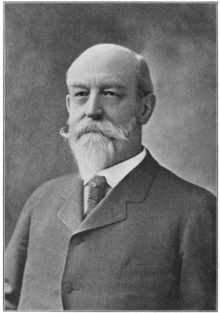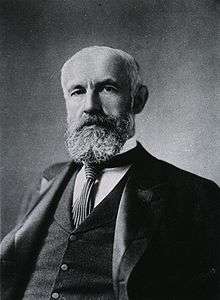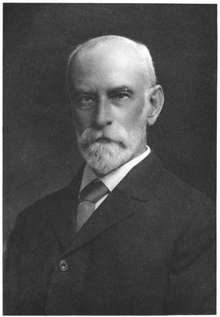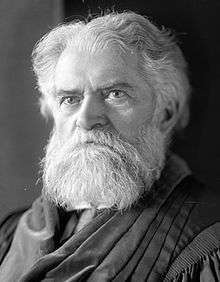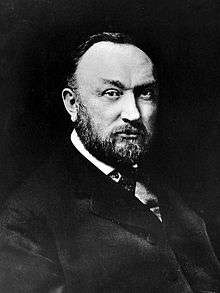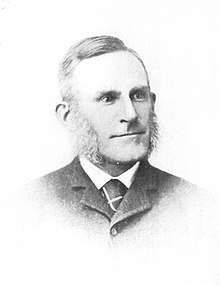American Society for Psychical Research
The American Society for Psychical Research (ASPR) is the oldest psychical research organization in the United States dedicated to parapsychology. It maintains offices and a library, in New York City, which are open to both members and the general public. The society has an open membership, anyone with an interest in psychical research is invited to join. It maintains a website; and publishes the quarterly Journal of the American Society for Psychical Research.[1]
| Abbreviation | ASPR |
|---|---|
| Formation | 1884 |
| Legal status | Non-profit organization |
| Purpose | Parapsychology |
| Location |
|
Region served | North America |
Membership | Psychical researchers |
Main organ | Journal of the American Society for Psychical Research |
| Affiliations | Society for Psychical Research |
| Website | www |
History
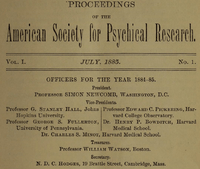
It was William Fletcher Barrett's visit to America that ultimately led to the formation of the American Society for Psychical Research in December, 1884.[2] Barrett was invited by several members of the American Association for the Advancement of Science. He persuaded intellectuals such as Edward Charles Pickering, Simon Newcomb, Alexander Graham Bell, Henry Pickering Bowditch and William James that the claims of psychical phenomena should be investigated scientifically.[2]
The first meetings of the society were held in the rooms of the American Academy of Arts and Sciences.[3] The founding members who were also the first Vice-Presidents were G. Stanley Hall, George Stuart Fullerton, Edward Charles Pickering, Henry Pickering Bowditch and Charles Sedgwick Minot.[4] Other founding members were Alpheus Hyatt, N. D. C. Hodges, William James and Samuel Hubbard Scudder.[5] The mathematician Simon Newcomb was the first President.[6]
Other early members included the psychologists James Mark Baldwin, Joseph Jastrow, and Christine Ladd-Franklin.[7][8] Initial research findings were discouraging.[9] By 1890, members such as Baldwin, Hall, Jastrow and Ladd-Franklin had resigned from the society.[8] Hall and Jastrow became outspoken critics of parapsychology.[10] Morton Prince and James Jackson Putnam left the ASPR in 1892 to form the American Psychological Association.[11]
Richard Hodgson joined the ASPR in 1887 to serve as its secretary.[12] In 1889, Fullerton, James and Josiah Royce were Vice-Presidents and Samuel Pierpont Langley served as President.[4] In 1889, a financial crisis forced the ASPR to become a branch of the Society for Psychical Research, and Simon Newcomb and others left.[13] Following the death of Hodgson in 1905 it achieved independence once more.[14]
In 1906, James H. Hyslop took up the position as secretary of the recreated organization, with the work being done at his residence in New York City. He once wrote his son, "My work is missionary, not mercenary." The intended name for the new organization was, "The American Institute for Scientific Research" which Hyslop had organized into two sections for the investigation of two separate fields: "A" was to deal with psychopathology or abnormal psychology.[15] Its Section "B" was to be concerned with what Hyslop called "supernormal psychology" or parapsychology. Section "A" never got off the ground. But Section "B" became the new and reorganized ASPR. One of the Institute's aims was to organize and endow investigations into telepathy, clairvoyance, mediumship, and kinetic phenomena. This work was to be carried out by "B."[16] The society remained in New York, where it remains as of 2015. During this period the ASPR was heavily involved in the investigation of medium Leonora Piper about whom William James would famously declare in 1890: "To upset the conclusion that all crows are black, there is no need to seek demonstration that no crow is black; it is sufficient to produce one white crow; a single one is sufficient." Since his proclamation of Piper as his "one White Crow", the concept of the single "White Crow" has become a cliché in psychical re-search.[17]
After evaluating sixty-nine reports of Piper's mediumship William James considered the hypothesis of telepathy as well as Piper obtaining information about her sitters by natural means such as her memory recalling information. According to James the "spirit-control" hypothesis of her mediumship was "somewhat incoherent, ambiguous, irrelevant, and, in some cases, demonstrably false—at best only circumstantial."[18] However, G. Stanley Hall believed Piper's mediumship had an entirely naturalistic explanation and no telepathy was involved. Hall and Amy Tanner, who observed some of the trances, explained the phenomena in terms of the subconscious mind harboring various personalities that pretended to be spirits or controls. In their view, Piper had subconsciously absorbed information that she later regurgitated as messages from "spirits" in her trances.[19]
On June 20, 1906, the ASPR had 170 members and by the end of November 1907, it had 677.[16] Hereward Carrington became a member of the ASPR in 1907 and an assistant to James Hyslop until 1908, during which time he established his reputation as an ASPR investigator. However his connection with the ASPR ceased due to lack of funds.[16] Carrington was the author the book The Physical Phenomena of Spiritualism which exposed the tricks of fraudulent mediums.[20] According to Arthur Conan Doyle, Carrington was not popular with spiritualists.[21]
James Hyslop died in 1920, and immediately strife broke out between the membership as the Society divided into two factions, one broadly pro-Spiritualism, indeed often Spiritualists, and the other 'conservative' faction favoring telepathy and skeptical of 'discarnate spirits' as an explanation for the phenomena studied, or simply skeptical of the phenomena's existence.[22] In 1923 a prominent Spiritualist, Frederick Edwards, was appointed President, and the conservative faction led by Gardner Murphy and Walter Franklin Prince declared that the Society was becoming less academic.[23] In the same year the ASPR lost 108 members.[24] New members joined the society and William McDougall a past President and Prince both became alarmed at the number of "credulous spiritualists" that joined the ASPR.[25]
In 1925 Edwards was reappointed President, and his support of the mediumistic claims of 'Margery' (Mina Crandon) led to the 'conservative' faction leaving and forming the rival Boston Society for Psychical Research in May, 1925. From this point on the ASPR remained highly sympathetic to Spiritualism until 1941, when the Boston Society for Psychical Research was reintegrated into the ASPR.[22]
Splinter group
The Boston Society for Psychical Research (BSPR) was founded in April 1925 by former research officer Walter Franklin Prince of the ASPR. Other founding members were William McDougall, Lydia W. Allison and Elwood Worcester. They were alarmed by the ASPR support for the purported medium Margery (Mina Crandon) and suppressing any reports unfavourable to her.[22][26]
Joseph Banks Rhine claimed to have observed Crandon in fraud in a séance in 1926. According to Rhine during the séance she was free from control and kicked a megaphone to give the impression it was levitating.[27] Rhine's report that documented the fraud was refused by the ASPR, so he published in it in the Journal of Abnormal and Social Psychology. In response, defenders of Crandon attacked Rhine. Arthur Conan Doyle published an article in a Boston Newspaper claiming "J. B. Rhine is an Ass."[27]
There was a significant split in the history of American psychical research: the American Society for Psychical Research had become dominated by those sympathetic to Spiritualism; the Boston Society favored a naturalistic explanation (such as telepathy; yet telepathy within the laws of undiscovered physics) for purported mediumship and was critical of the purported mediumship of Mina Crandon in particular.[14] Under President Walter Franklin Prince it organised the investigation of Mina during the Scientific American Prize dispute, and Harry Houdini worked with the group. BSPR investigators were involved in the uncovering of the alleged fraud of Mina Crandon—including a number of revelations often credited to Harry Houdini, but actually discovered by other BSPR members. In 1923, Prince described the Crandon case as "the most ingenious, persistent, and fantastic complex of fraud in the history of psychic research."[28] The BSPR fell into obscurity following exposure of Mina Crandon, and was formally reincorporated into the American Society for Psychical Research in 1941.[29]
In 1934 the BSPR published Extrasensory Perception[30] by their member Joseph Banks Rhine, who introduced the term ESP to English, and the methodology of modern parapsychology, with its quantitative research and laboratory based approach, as distinct from the older psychical research.
Founders
See also
- International Association for Near-Death Studies
- Institut suisse des sciences noétiques
- Parapsychological Association
- Outline of parapsychology
References
- American Society for Psychical Research website
- Fichman, Martin. (2004). An Elusive Victorian: The Evolution of Alfred Russel Wallace. University of Chicago Press. p. 111. ISBN 0-226-24613-2
- Ferrari, Michel. The Varieties of Religious Experience: Centenary Essays. Imprint Academic. pp. 19–20. ISBN 0-907845-26-6
- James, William. (1986). Essays in Psychical Research. Harvard University Press. p. 381. ISBN 0-674-26708-7
- "Miscellaneous Intelligence". American Journal of Science. 1885, p. 83. "The Committee appointed consists of nine gentleman, viz: G. Stanley Hall (Chairman), E. C. Pickering, William James, Alpheus Hyatt, Samuel H. Scudder, H. P. Bowditch, C. S. Minot, William Watson, N. D. C. Hodges (Secretary)."
- Taylor, Eugene. (2009). The Mystery of Personality: A History of Psychodynamic Theories. Springer. p. 30. ISBN 978-0-387-98103-1
- Clegg, Joshua W. Self-Observation in the Social Sciences. Transaction Publishers. p. 53. ISBN 978-1-4128-4949-4 "The American Society for Psychical Research (ASPR), which James helped found in 1884, was initially populated by a number of early psychologists. These included James's student G. Stanley Hall, as well as James Mark Baldwin, Joseph Jastrow, and Christine Ladd-Franklin."
- Pickren, Wade; Rutherford, Alexandra. (2010). A History of Modern Psychology in Context. Wiley. ISBN 978-0-470-27609-9 "Psychologists Hall, Baldwin, Joseph Jastrow, and Christine Ladd-Franklin... had dropped their affiliation by 1890."
- Misiroglu, Gina. (2015). American Countercultures: An Encyclopedia of Nonconformists, Alternative Lifestyles, and Radical Ideas in U.S. History. Routledge. p. 244. ISBN 978-0-7656-8060-0 "The American Society took a more skeptical view of psychic phenomena than did its British counterpart, and, led by prominent men of science, was more open to mundane explanations. Still, initial research findings were disappointing, and the interest of many scientific members waned. Under the direction of nonscientists, the ASPR languished for many years."
- Kurtz, Paul. (1985). A Skeptic's Handbook of Parapsychology. Prometheus Books. p. 551. ISBN 978-0-87975-300-9
- Ward, Steven. (2002). Modernizing the Mind: Psychological Knowledge and the Remaking of Society.Praeger. pp. 43–44. ISBN 978-0-275-97450-3
- Rosemary Guiley. (1994). The Guinness Encyclopedia of Ghosts and Spirits. Guinness Publishing. p. 164. ISBN 978-0-85112-748-4
- Deborah Blum. (2006). Ghost Hunters: William James and the Search for Scientific Proof of Life After Death. Penguin Books. ISBN 978-0-14-303895-5
- Mauskopf, Seymour. (1982). Psychical Research in America. In Ivor Grattan-Guinness. Psychical Research: A Guide to Its History, Principles & Practices. Aquarian Press. ISBN 978-0-85030-316-2
- Hyslop, James (1907). "Editorial". Journal of the American Society for Psychical Research: 1, 38.
- Arthur Berger. (1988). Lives and Letters in American Parapsychology: A Biographical History, 1850–1987. McFarland & Company. pp. 51–55 ISBN 978-0-89950-345-5
- Melton, J. Gordon (2001). Encyclopedia of Occultism and Parapsychology (5th ed.). Farmington Hills, MI: Gale Group, Inc. p. 822.
- Francesca Bordogna. (2008). William James at the Boundaries: Philosophy, Science, and the Geography of Knowledge. University Of Chicago Press. p. 127. ISBN 978-0-226-06652-3
- Amy Tanner. (1910). Studies in Spiritism. New York: Appleton.
- Hereward Carrington. (1907). The Physical Phenomena of Spiritualism. Herbert B. Turner & Co.
- Massimo Polidoro. (2001). Final Séance: The Strange Friendship Between Houdini and Conan Doyle. Prometheus Books. p. 143. ISBN 978-1-57392-896-0
- Clément Chéroux. (2005). The Perfect Medium: Photography and the Occult. Yale University Press. pp. 217-234 ISBN 978-0-300-11136-1
- Rosemary Guiley. (1994). The Guinness Encyclopedia of Ghosts and Spirits. Guinness Publishing. pp. 48–50. ISBN 978-0-85112-748-4
- David Hess. (1993). Science In The New Age: The Paranormal, Its Defenders & Debunkers, (Science & Literature). University of Wisconsin Press. p. 25. ISBN 978-0-299-13824-0 "A sharp divide between Spiritualists and psychical researchers had already occurred in 1923, when pro-Spiritualist forces gained control of the American Society for Psychical Research (ASPR), ousted President William McDougall, and demoted Hyslop's chosen successor, the psychologist Walter Franklin Prince, who resigned in 1925. The ASPR lost 108 members in 1923, and the controversy over the claimed physical effects of the medium named "Margery" sealed the division."
- Robert Laurence Moore. (1977). In Search of White Crows: Spiritualism, Parapsychology, and American Culture. Oxford University Press. p. 176. ISBN 978-0-19-502259-9
- Williams, William F. (2000). Encyclopedia of Pseudoscience: From Alien Abductions to Zone Therapy. Routledge. p. 40. ISBN 1-57958-207-9
- Massimo Polidoro. (2001). Final Séance: The Strange Friendship Between Houdini and Conan Doyle. Prometheus Books. pp. 202–203. ISBN 978-1-57392-896-0
- C. E. M. Hansel. (1989). The Search for Psychic Power: ESP and Parapsychology Revisited. Prometheus Books. p. 245. ISBN 978-0-87975-533-1
- Thomas Tietze. (1973). Margery. Harper & Row. ISBN 978-0-06-068235-4
- Joseph Banks Rhine. (1934) Extra-Sensory Perception. Boston: Boston Society for Psychic Research.
Further reading
- Anonymous. (1885–1889). Formation of the Society. Proceedings of the American Society for Psychical Research. 1: 1–2.
- Georgess McHargue. (1972). Facts, Frauds, and Phantasms: A Survey of the Spiritualist Movement. Doubleday. ISBN 978-0-385-05305-1
- Robert Laurence Moore. (1977). In Search of White Crows: Spiritualism, Parapsychology, and American Culture. Oxford University Press. ISBN 978-0-19-502259-9
